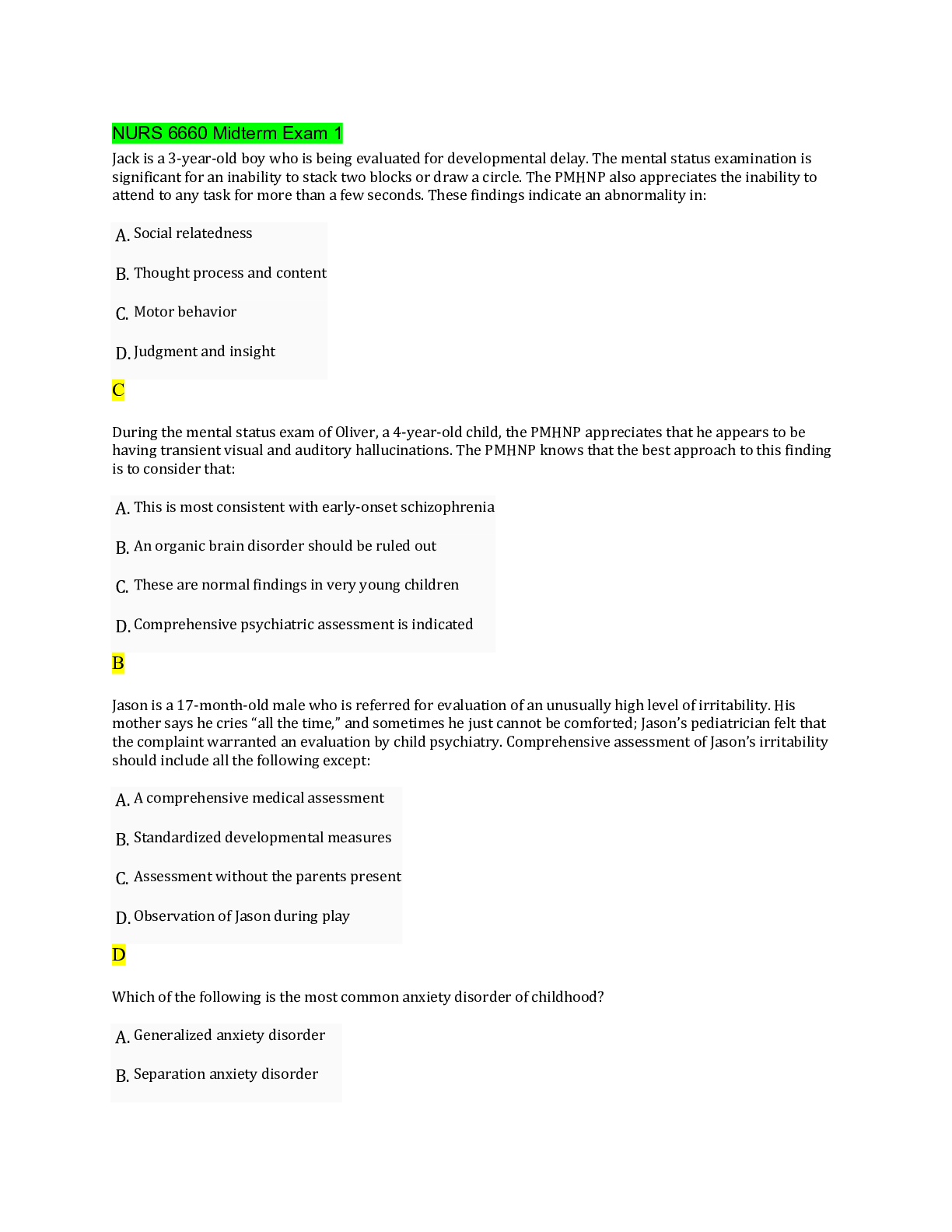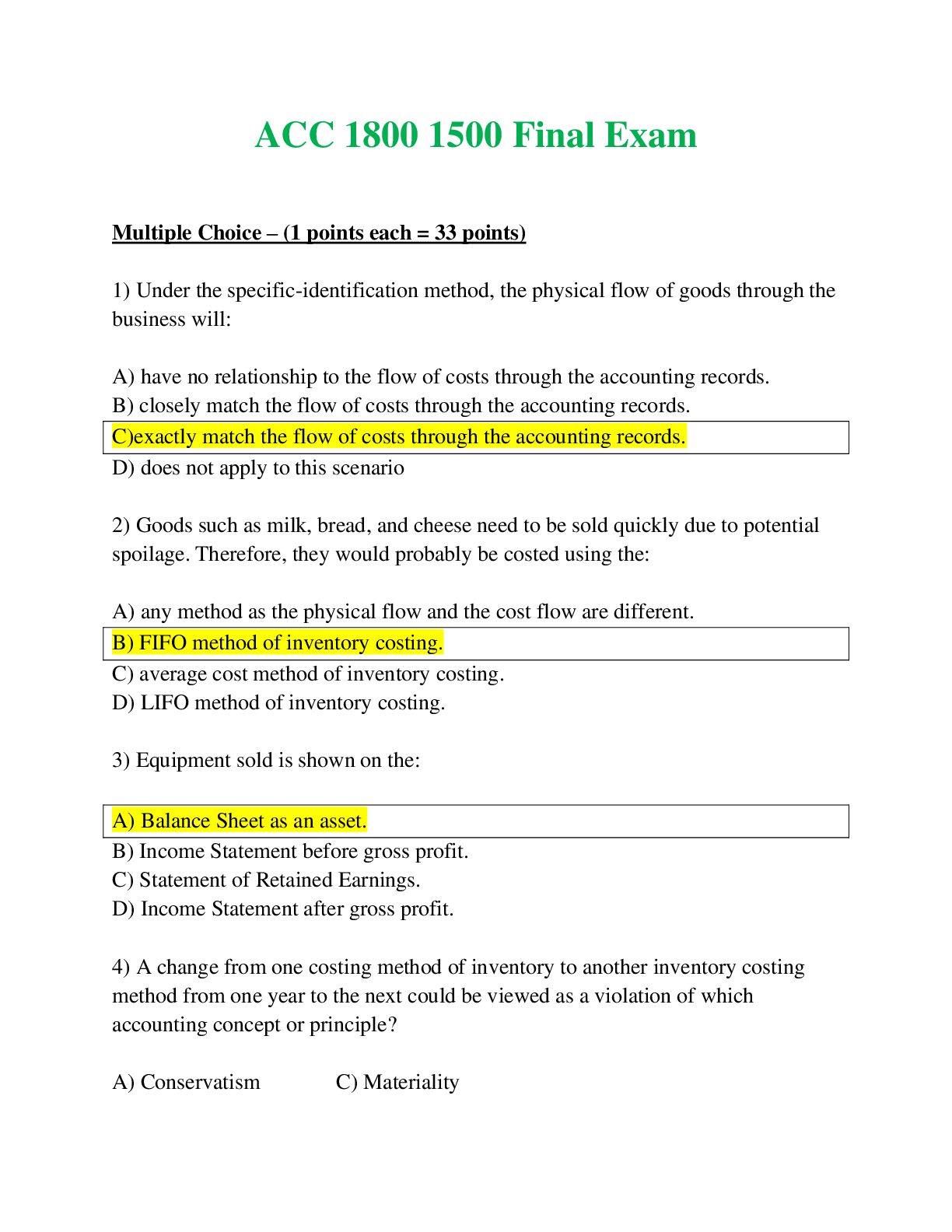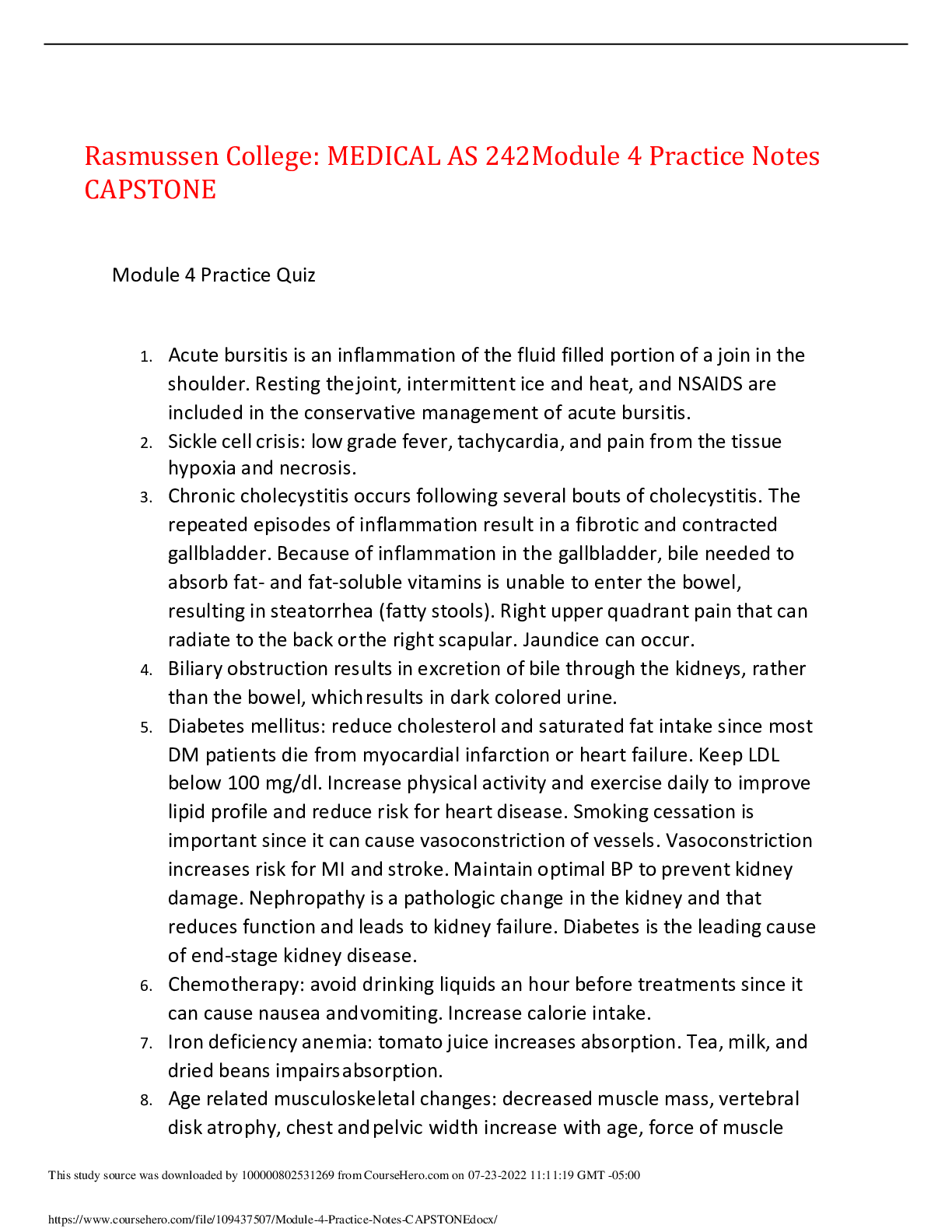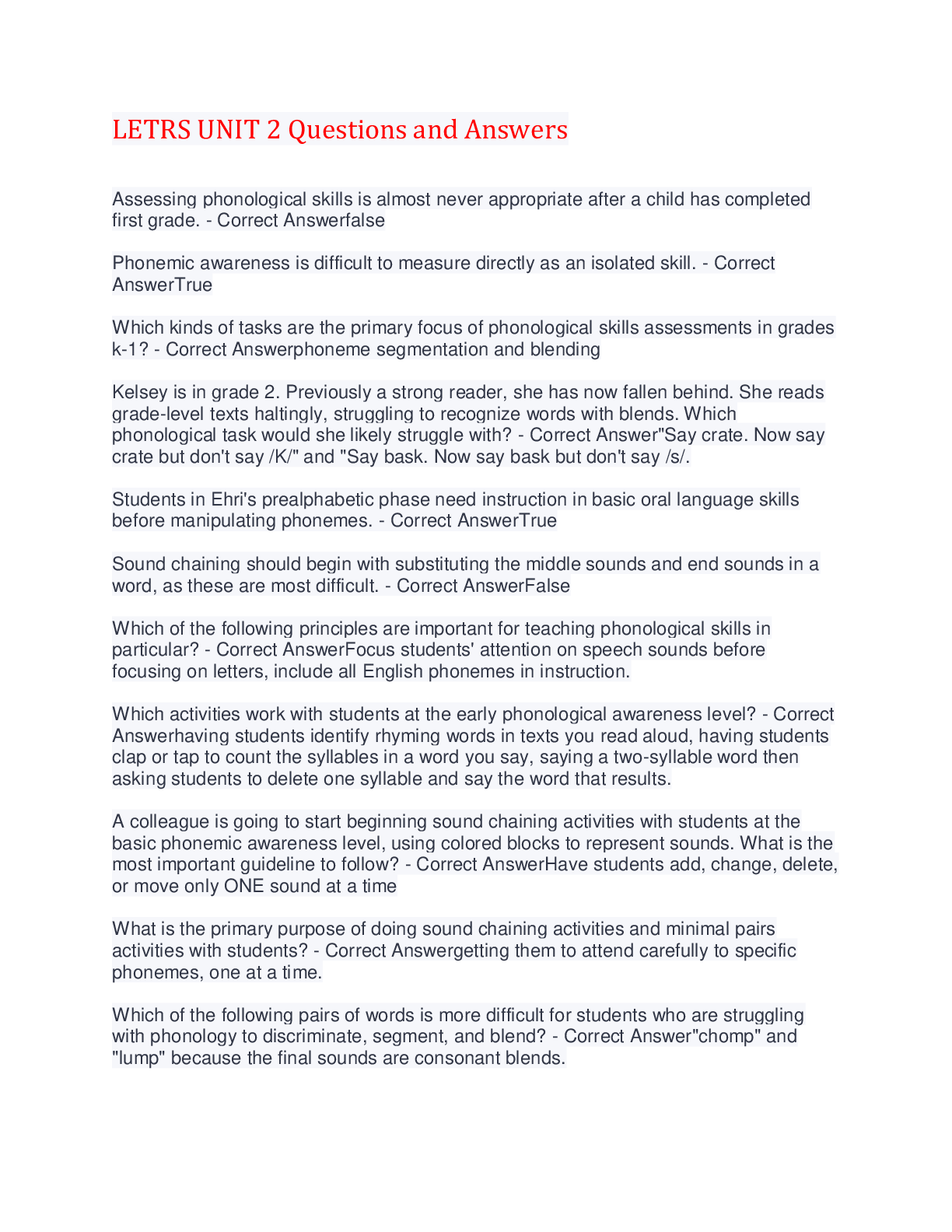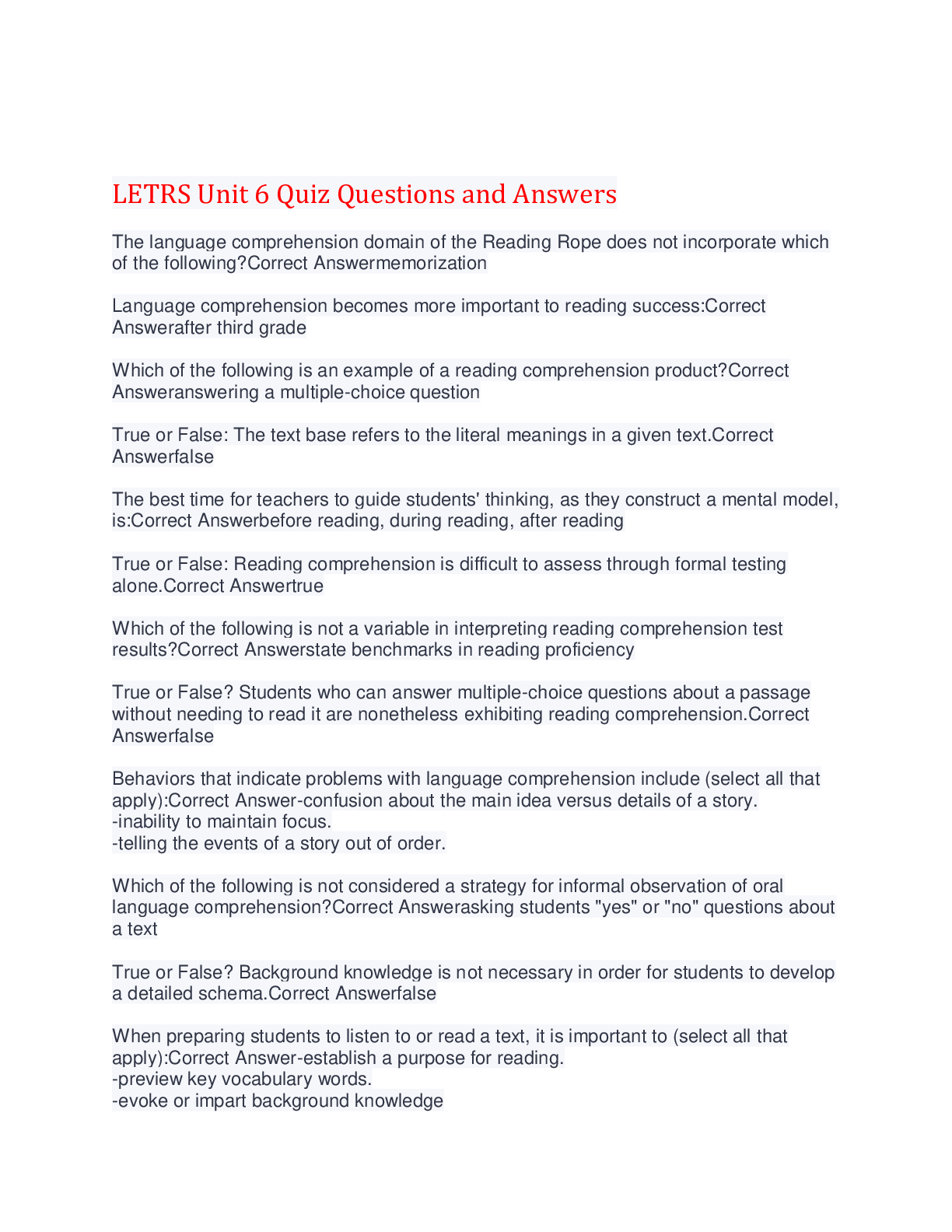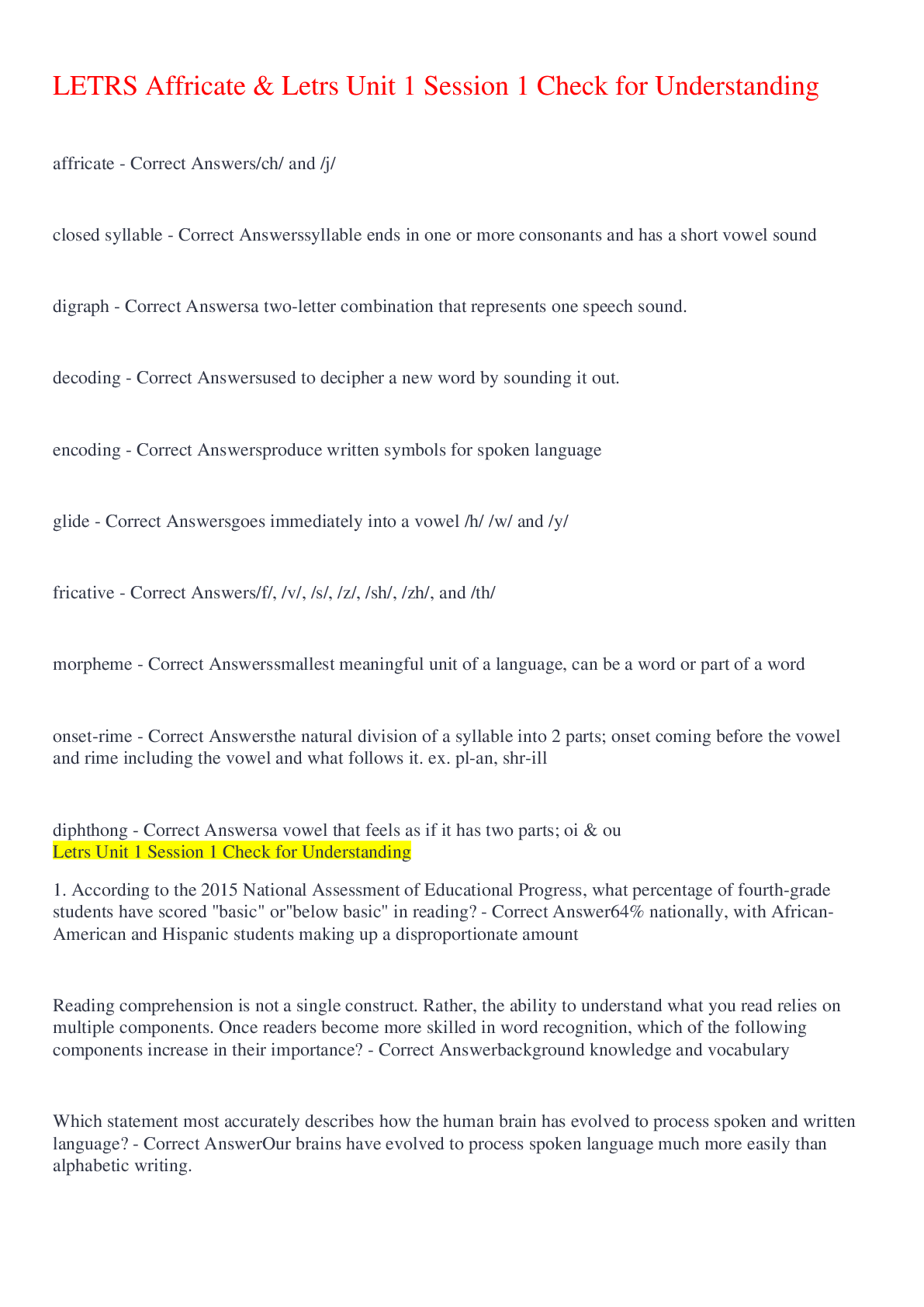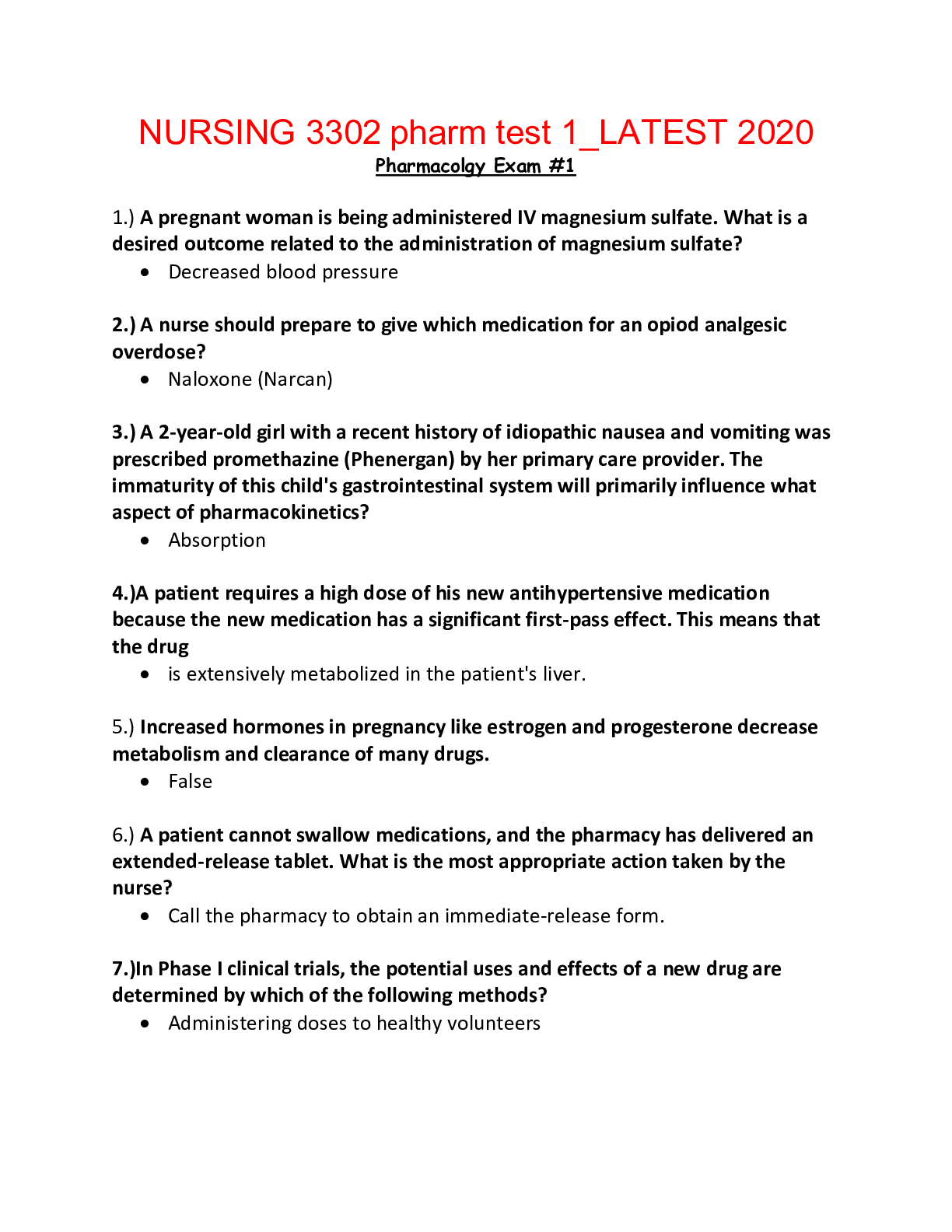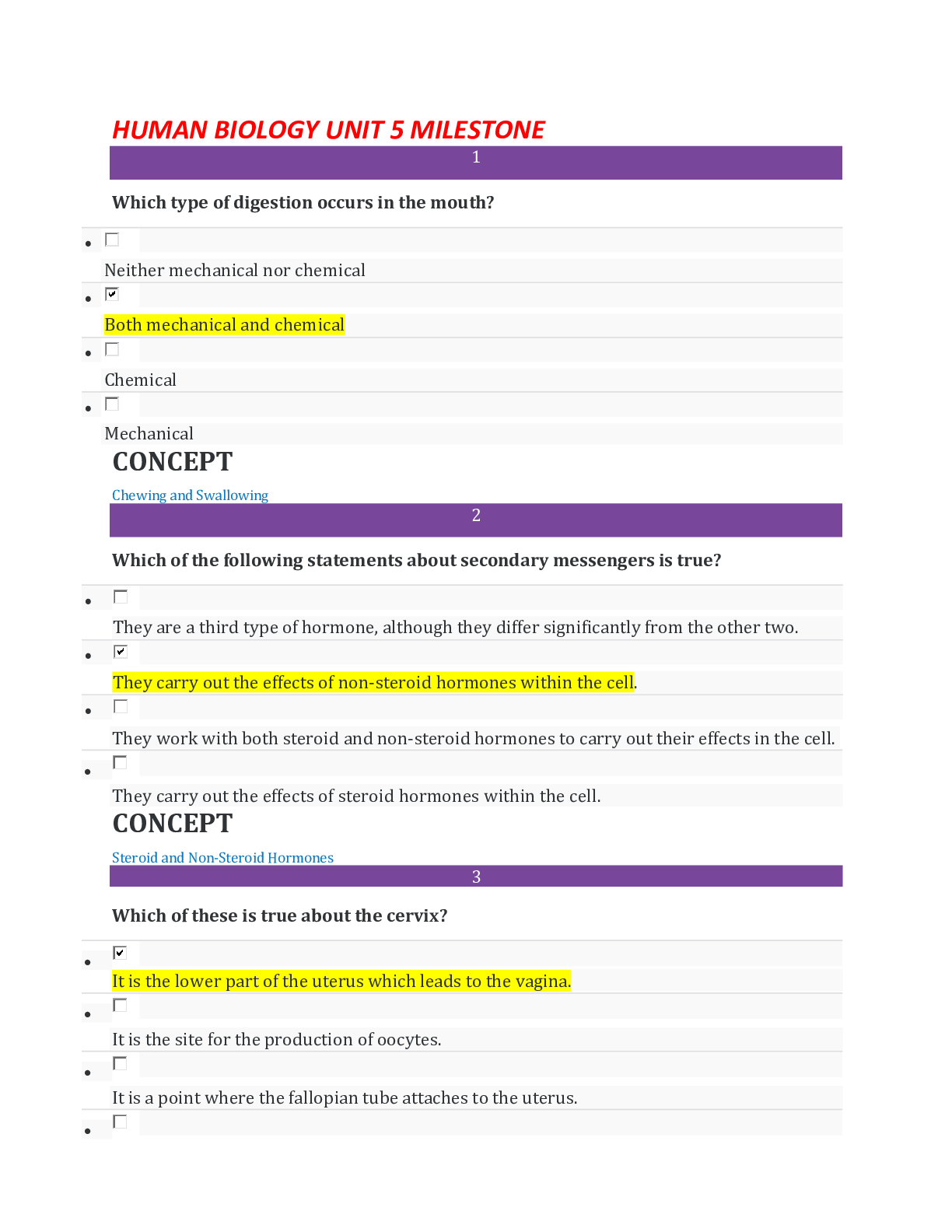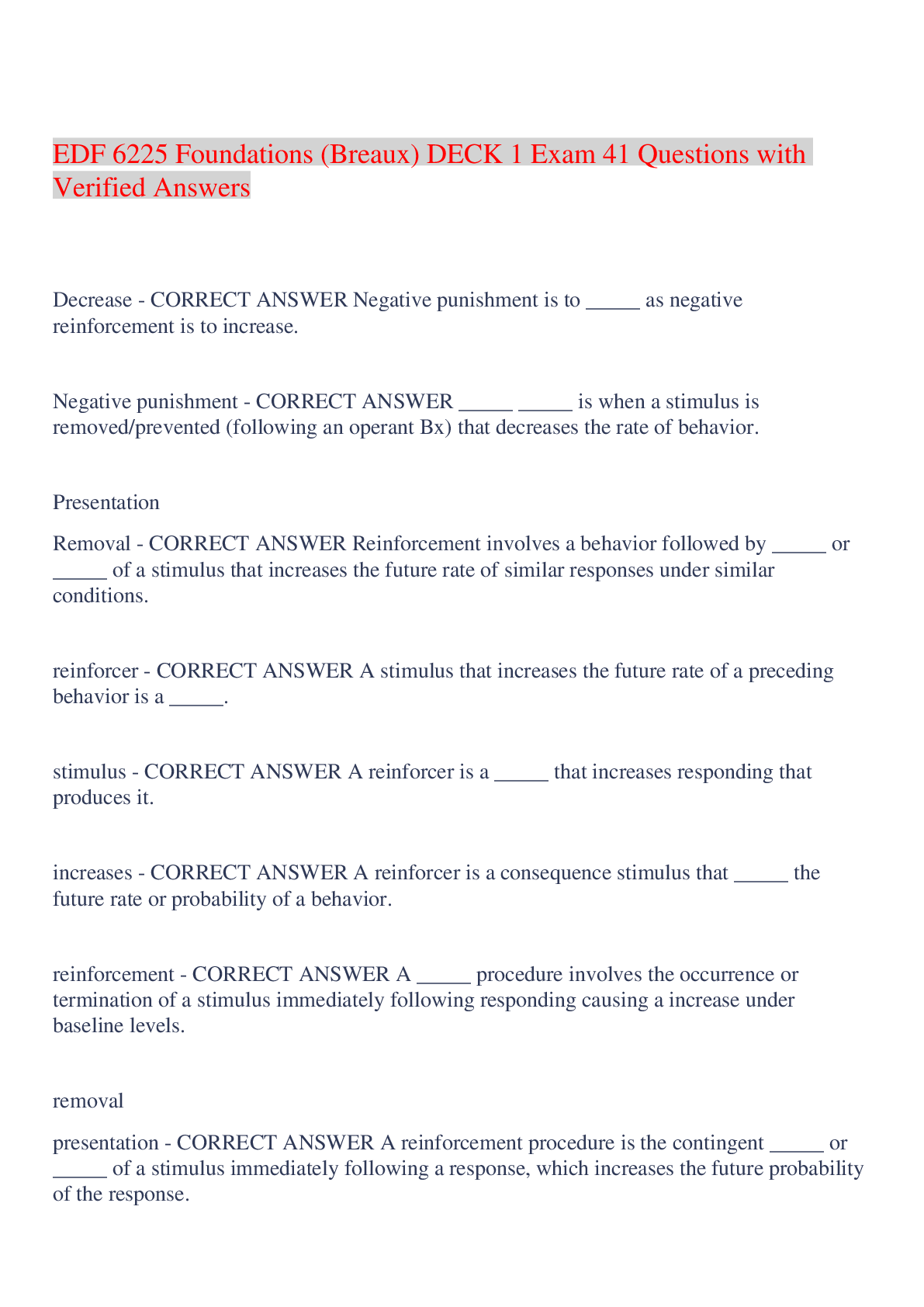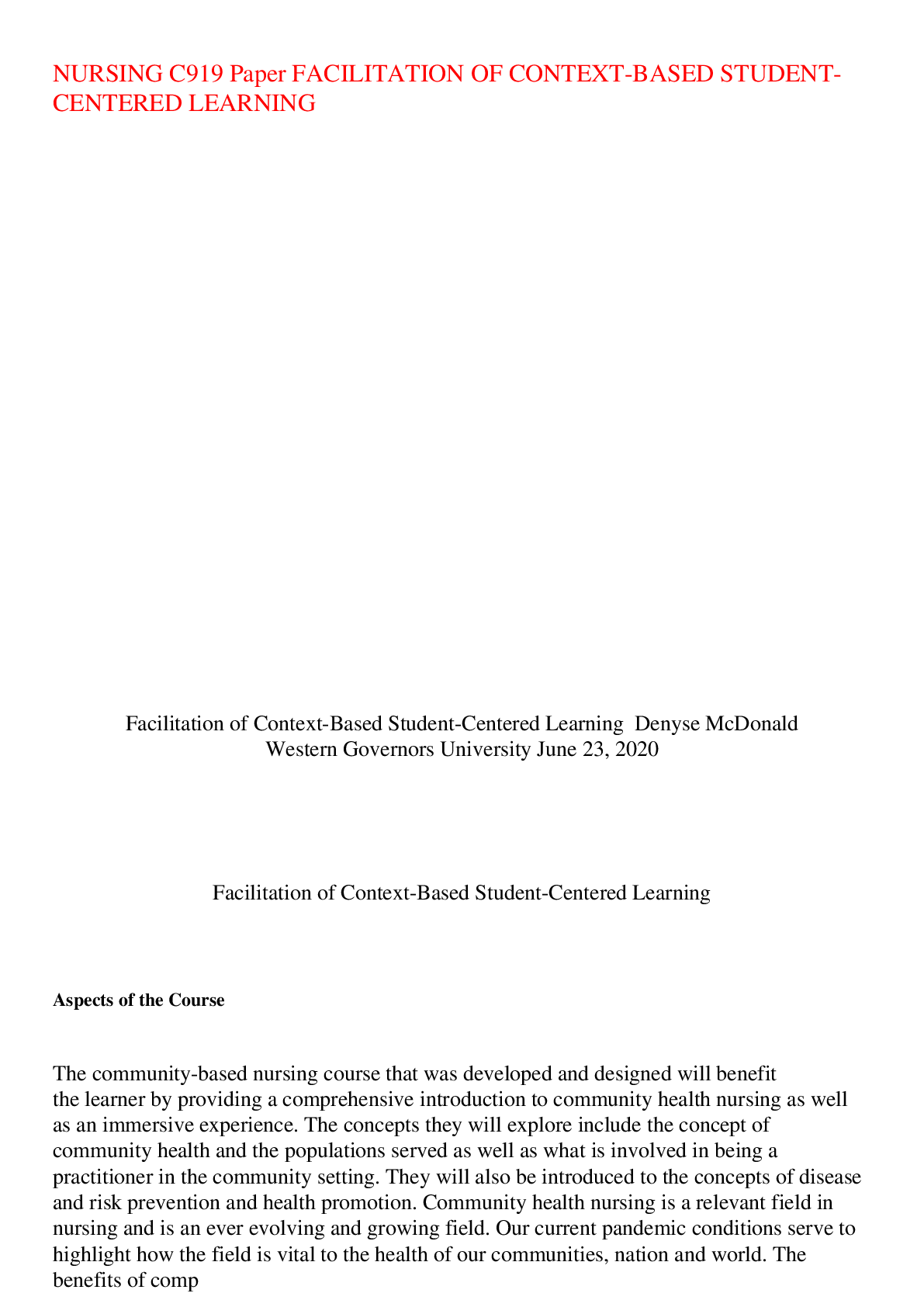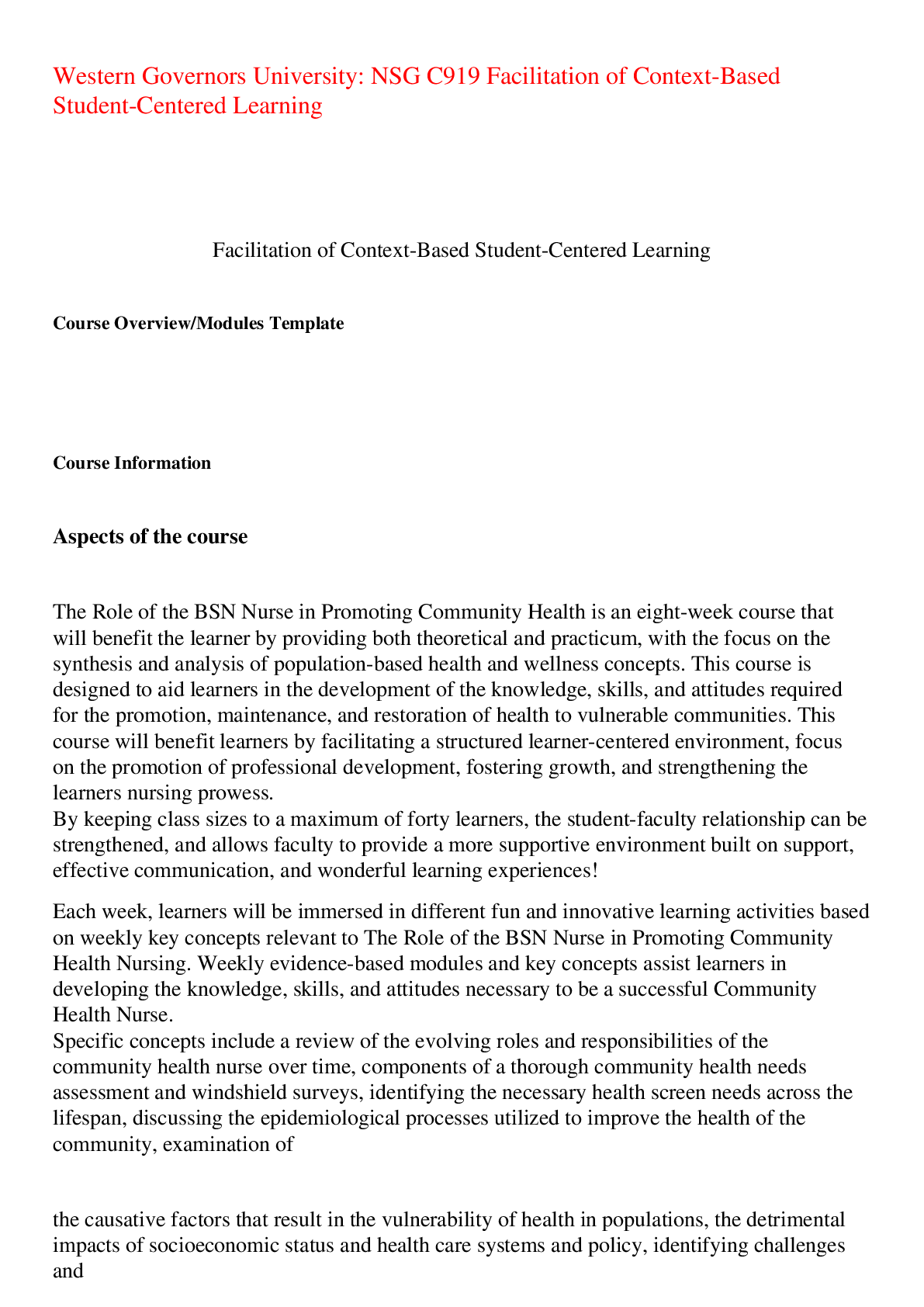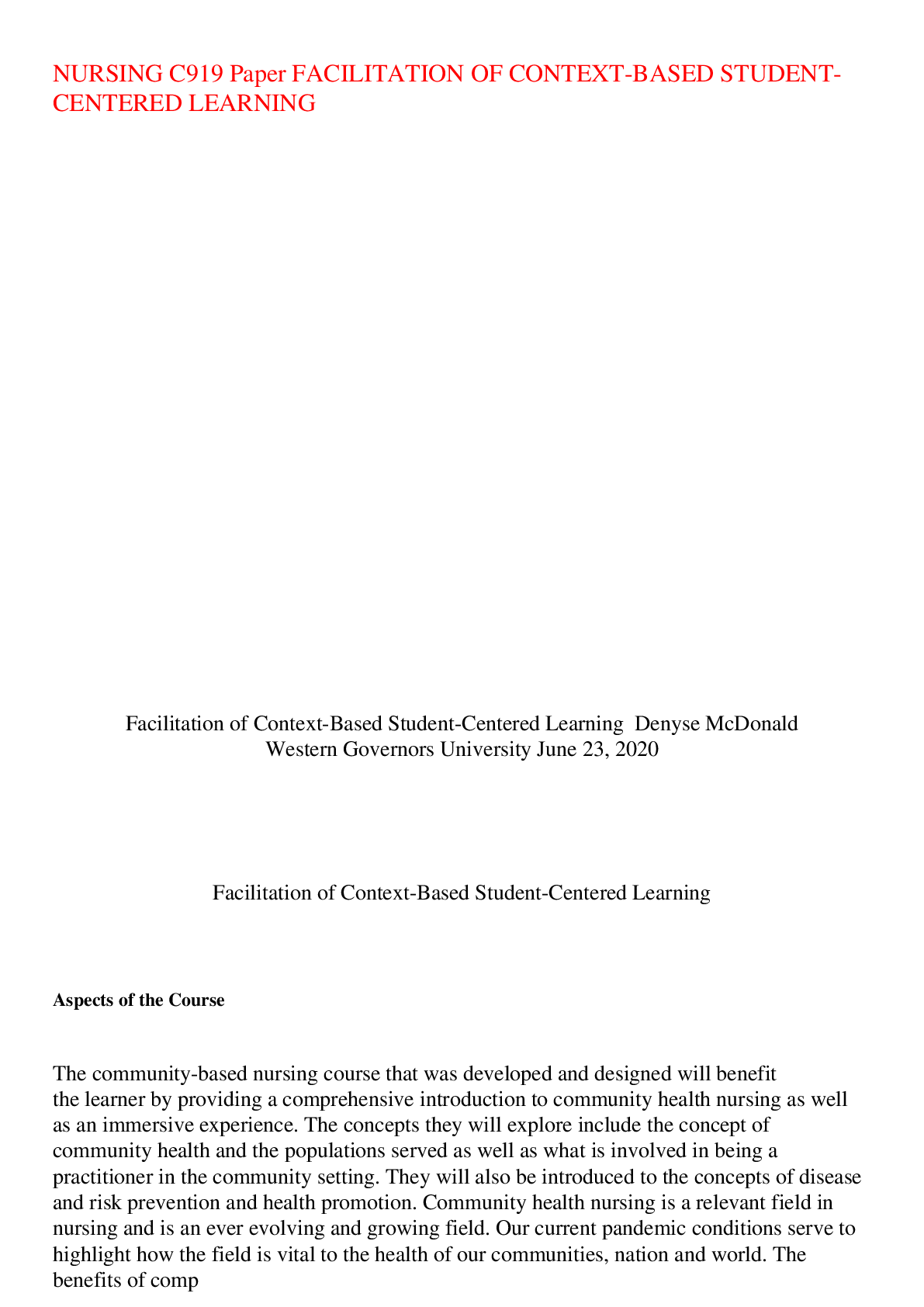*NURSING > EXAM > Western Governors University :MSN ED C919 Facilitation of Context-Based Student-Centered Learning,10 (All)
Western Governors University :MSN ED C919 Facilitation of Context-Based Student-Centered Learning,100% CORRECT
Document Content and Description Below
Western Governors University :MSN ED C919 Facilitation of Context-Based Student-Centered Learning Shameka Nall B1. ASPECTS OF THE COURSE The learner will benefit from this course by gaining... new knowledge of the role of a community health nurse in the more complex setting. The concepts they will learn about are the role of the community health bachelor's prepared nurse, assessment of a community and how to address community needs, community health prevention, maintenance, and education, as well as local and global health trends, epidemiology and disease. Community health nursing is essential to the health and care of the public. The learner will also benefit from knowing the evidence-based practices associated with community health nursing. Another objective of the course is that the learner is also going to understand how healthcare laws are made regarding the community and the profession. This will broaden their perspective from a top down and bottom up approach and how to go about lobbying for changes in the profession and community. The relevance of community health to the nursing profession is that it focuses on the health and education of the whole community and population to prevent disease at the first local then global level. B2. CULTIVATION OF COURSE Each module will be conducted in a fashion that flows weekly into each different layer of the role of a community health nurse and the aspects that comprise community health nursing. We will start with an introductory module "Introduction of the role of the BSN in the community health setting”. The concept for this module is to identify what community health nursing is and the different roles of the nurse that may aid in the community setting. Learner will also look at the different types of community settings (rural, urban, etc.) and the demographics associated with each type of setting. We will flow to the next module in week 2, “Communicable Disease & Epidemiology”. In this module students will learn about key terms such as prevalence, incidence, and recurrence. They will also learn about what communicable disease is and how they affect communities. The learners will also identify barriers to the prevention of communicable diseases. This module should also help identify why nursing at the community level is needed to prevent or decrease the incidence of disease. The 3rd module will address assessing the community, how to plan for care, and intervention implementation at the community level. Here the students will look at assessment strategies to determine the needs of a community depending on the demographics and location. They will then learn care planning for the community based on the assessment and identified needs. Learners will also identify how to evaluate community level interventions and reassess for needs. In the 4th module, Health Maintenance and Promotion, we will discuss prevention (primary, secondary and tertiary) of disease. Methods for community education and activities to promote health at the community level will also be determined. The 5th module will be focused on cultured-based care and vulnerable populations. This should be easy to digest after the discussion from the previous weeks that will have identified different communities and demographics associated with each. This module will look at how different cultures view healthcare and how to assist vulnerable populations (such as older adults living alone) in the community. The 6th module will uncover healthcare systems and policies. Here we will understand how laws and policies that affect nursing and community care are put into place. Students will learn the proper procedure for submitting a policy brief to the appropriate local officials and how they can lobby for change. In this module they will also learn about all the terms that make up health care systems (leadership, finance, information, service, human resources and operating systems or technology). Disaster Management and Community Preparedness, the 7th module, will identify how to plan and activate the emergency response system within a community. It will also look at emergency triage in the case of mass casualty events. This module will discuss the role of the community health nurse in the management and/or preparation of the community in a mass disaster. The final module will pertain to “Global Healthcare Trends”. In this module learners will review health trends affecting different communities in other countries at the global level. After learning about how health is affected locally and nationally, students need to identify different policies, interventions and organizations in place that affect the communities of other countries. Interventions and health policies of other countries will be compared to local or national interventions and policies. Students may learn to incorporate some global community interventions or simply broaden their perspective on community-based care at the global level. B3. STUDENT-CENTERED LEARNING Each week the class will be expected to have read ahead of the module and should be prepared to have full discussion when the module is started. This is called flipping the classroom and this facilitates learning because learners will have read ahead and already have their questions or muddy points identified so that they can be explained during class time (Billings & Halstead, 2016). This should help the learners get a thorough understanding of the role of the BSN within the community setting and provide opportunities for clarification of ideas or new concepts. In the introductory module, we will watch some videos with some community health nurses explaining their roles and what community health nursing entails. Lecturing paired with videos in the first module will lay the foundation for future knowledge for the learners to build upon and facilitate student-centered learning by keeping the learners engaged throughout the lecture (Billings & Halstead, 2016). The second module (Communicable Disease & Epidemiology) will utilize team-based learning with case study reviews to promote student-centered learning (Billings & Halstead, 2016). The learners should have read ahead before this module. I will allow them to separate into groups where a captain and a scribe will be elected to write and present. Each team will have a topic and will be tasked to find a case study relative to the concept of epidemiology and communicable disease. Each captain will then present the case study and discussion of their group to the other learners in the class. The goal is to facilitate learning and application of the terms relating to the concept of communicable disease and epidemiology to gain a clear understanding. Student-centered learning is facilitated because each person in the group is responsible for each member of the group to learn the concept. The 3rd module is “Community Health Assessment and Planning” and we will work to understand this term using concept mapping. The students will again, have read the materials beforehand. During class time they will be expected to complete a concept map within a small group that will help facilitate knowledge of community planning after conducting a needs assessment for a community. I will supply them with a possible community health assessment topic, and they will be tasked to map the planning and interventions that are appropriate for the assessment (Velonis, Molnar, Lee-Foon, Rahim, Boushel, & O’Campo, 2018). The 4th module, “Health Maintenance & Promotion”, and for this class I will put together a Kahoot like game where there will be questions or scenarios. The learners will answer the questions or provide the best approach to a scenario concerning health promo in a community. According to Bastable, gaming is primarily effective for improving cognitive functioning and may be used to enhance skills in the psychomotor domain and influence affective behavior through increased social interaction (Bastable, 2019). When discussing the 5th module, “Culture-based Healthcare and Vulnerable Populations in the Community”, we will use problem-based learning as an active learning technique. Our text outlines that problem- based learning is student centered and has five steps: analysis of problems, establishment of learning outcomes, collection of information, summarizing, and reflection (Billings & Halstead, 2016). The learners will work in small groups and identify problems in culturally based care and/or vulnerable populations within the community. They will then have to devise solutions that fit within the realm of the BSN role in the community health care setting. Problem based learning is intended to facilitate learning because it is student centered and is should foster a spirit of inquiry for future learning (Kandi & Basireddy, 2018). When discussing the 6th module, “Health Care Systems & Policies”, I will have each learner email me a question that they will form from the reading ahead. I will then arrange the questions in a Jeopardy style game where the learners will compete to answer questions. I will assemble the questions into different categories and create a point system that addresses easier to increasingly harder questions. Classroom gaming is an affective learning strategy because it improves cognition and it will increase social engagement within the learning environment (Bastable, 2019). The 7th week will use concept mapping to discuss “Disaster Management & Community Preparedness”. Concept mapping for this module will facilitate learning of prioritization in the steps of emergency response activation. This will also help them identify who will do what within the system. The aim of concept mapping is to promote student-centered learning because concept mapping appeals to the visual learners as well as the kinetic learners. Our text states that mapping strategies encourage better understanding and recall of complex phenomena and are especially effective in stimulating long-term recall of like concepts. They require active involvement by the students in designing the maps to enhance conceptual thinking processes (Billings & Halstead, 2016). When put into groups to work together on the maps, discussion of the topic will also engage the auditory learners. Concept mapping has also been found to stimulate critical thinking skills in nursing students (Kaddoura, VanDyke, Cheng, & Shea-Foisy, 2016). The learners will review case studies to facilitate student-centered learning of “Global Health Trends”. Case studies will facilitate learning regarding global health care initiatives and which organizations do what within the global health level. Learners can also use case studies to compare U.S. health trends to the efforts of other countries. Our textbook states that review of case studies offers effective assistance in the retention and recall of information (Billings & Halstead, 2016). B3a. PROFESSIONAL STANDARDS AND GUIDELINES: According to the American Association of College of Nursing, The Essentials outline the necessary curriculum content and expected competencies of graduates from a baccalaureate program (American Association of Colleges of Nurses, 2008). The weekly key concepts align with the 9 Essentials of Baccalaureate Education for Professional Nursing Practice. • Essential I: Liberal Education for Baccalaureate Generalist Nursing Practice o A solid base in liberal education provides the cornerstone for the practice and education of nurses. Liberal education empowers individuals and prepares them to deal with complexity, diversity, and change and provides students with a broader knowledge of the world in relation to science, culture, and society (Association of American Colleges & Universities, 2019). This aligns with all the concepts because community-based health care deals with all the above. The subject deals with culture and society in relationship to nursing which is rooted in science. The complexity of community-based care will be simplified to the learners taking this course and through the breakdown of the subject through all the weekly modules. The toolkit identifies that we can elaborate on this essential by providing local, national, and international experiences, framed by reflective questions, in a variety of cultures, organizations, and communities. • Essential II: Basic Organizational and Systems Leadership for Quality Care and Patient Safety o Knowledge and skills in leadership, quality improvement, and patient safety are necessary to provide high quality health care. Learners will discover how to safely care for the communities and their families throughout this course. Leadership skills and quality improvement strategies will be discussed in module “Health Systems and Policies”, however these learners will also passively develop leadership skills throughout the group work that will be conducted in the course. In utilizing using learning-based games, we will also propose a scenario where an innovative solution to a system-related patient care problem will need to be identified. • Essential III: Scholarship for Evidence Based Practice o Professional nursing practice is grounded in the translation of current evidence into practice. The active learning strategies from modules 2 and 8 will incorporate reviewing case studies that will identify best practice for “Communicable Disease and Epidemiology” and “Global Health Trends”. When researching journals and reviewing case studies, the learners will be urged to utilize best practice within their professional realm. Reviewing case studies that delineate evidenced based practice prepares the learners for the use of scholarship and creates a spirit of inquiry in the learners. While both modules will utilize case studies as a learning strategy, I can use samples of nursing journals and ask students to identify a research article and determine the type and level of evidence included. This will also foster a spirit of inquiry as identified by the essentials toolkit as a method to increase understanding of the concept and understanding the different kinds of studies and how and when to use them. • Essential IV: Information Management and Application of Patient Care Technology o Knowledge and skills in information management and patient care technology are critical in the delivery of quality patient care. In module “Health Care Systems and Policy”, we will also discuss patient care through use of technology and information management. This module will discuss various patient care technological resources that are useful within the community such as patient portal apps for smart devices, remote telemetry equipment for the home, and electronic medication systems that tracks patient medications and reorders them as needed. Learners will need to become versed in various forms of technology that will improve patient- centered care. • Essential V: Healthcare Policy, Finance, and Regulatory Environments o Healthcare policies, including financial and regulatory, directly and indirectly influence the nature and functioning of the healthcare system and thereby are important considerations in professional nursing practice. In week 6 we will use learning-based games to facilitate learner understanding of how health policy, financial and regulatory environments will influence community health nursing. Understanding different aspects of policy and the different categories that encompass health systems will give the learner a broadened understanding of how these topics influence the profession and its freedoms and its limitations. During this module the learners can also practice writing a policy brief in order to understand the approach to seeing changes in healthcare that affect the nursing profession and patient care. • Essential VI: Interprofessional Communication and Collaboration for Improving Patient Health Outcomes o Communication and collaboration among healthcare professionals are critical to delivering high quality and safe patient care. Learners may learn about collaboration during the health maintenance and promotion module. This is where community health nurses can work with local businesses (health or non-health related) to provide interventions to the community. Learners will understand why collaboration and communication among other health care providers will improve health care outcomes. In this module we will utilize learning-based games and the game should also incorporate ways to participate in collaboration and communication among other health care professionals. • Essential VII: Clinical Prevention and Population Health o Health promotion and disease prevention at the individual and population level are necessary to improve population health and are important components of baccalaureate generalist nursing practice. Again, the concept of health promotion and prevention will be outlined in week 4. This essential aligns with the subject of community health because the learners will be able to apply the concepts promotion and prevention on the community health level. Prevention and promotion is the center of community health nursing. Nurses are responsible for education of the public and providing interventions that will prevent disease or reduce incidences of occurrence. The learners will be able to identify how to use these interventions within the community setting and why prevention is the first line of defense against disease. Education in this section will be geared towards how to conduct health screenings, teaching about and providing immunizations based on age and risk factors, and health counseling strategies. • Essential VIII: Professionalism and Professional Values o Professionalism and the inherent values of altruism, autonomy, human dignity, integrity, and social justice are fundamental to nursing. This course will place an emphasis on the values of altruism, autonomy, human dignity, integrity and social justice and build upon the learners’ knowledge of those concepts. When discussing vulnerable populations and cultural sensitivity, we will expand what we already know about these values and apply them to the community sector of nursing. To ensure the understanding of these values in accordance to community health, we will look at each one and discuss how they can be applied in the setting. We can also incorporate these values in our problem-based learning exercises by discussing scenarios that may compromise these values and how to avoid discrepancy concerning the nursing values relating to patient care within the community. The toolkit states that in order to improve understanding of the values, I will need to have the students conduct a self-assessment in one or more of the following areas: physical, emotional, spiritual, cultural, relationships, communications, and learning style. Based on this assessment, the student can develop an improvement plan that includes measurable outcomes. • Essential IX: Baccalaureate Generalist Nursing Practice o The baccalaureate-graduate nurse is prepared to practice with patients, including individuals, families, groups, communities, and populations across the lifespan and across the continuum of healthcare environments. By the end of the course, each module will have collectively prepared the learner for care of families and patients in the community setting and populations across the lifespan. In each module we will address strengthening the learners’ knowledge of care of the community, families, patients, and individuals. We will review case studies to identify evidence-based practice regarding the community and its patients and families. Using evidence-based practice to discuss care in the environment of the community will foster application of the practice in the future. o The baccalaureate graduate understands and respects the variations of care, the increased complexity, and the increased use of healthcare resources inherent in caring for patients. Also, by the end of this course the learner will be able to identify resources in the community and apply those resources to provide patient centered care. When discussing prevention and health promotion, community resources should be incorporated and elaborated upon. The learner will gain knowledge of how to apply resources to variations in care or complexed community-based care. (American Association of Colleges of Nurses, 2008). B4. ALIGNMENT OF WEEKLY KEY CONCEPTS TO OVERVIEW The course overview gives the learner insight as to what the class is going to cover. Each concept that the learner will learn is listed in the overview to create an idea of what is to be expected to learn in this class. The overview states that this course will identify the role of the BSN in the community. The concepts that will facilitate student based learning are within the course overview: planning of a community, health promotion and maintenance, communicable disease prevention and epidemiology, global health trends, health policy, community culture & caring for vulnerable populations will learn about It identifies what the learner should be able to grasp once the course is complete. The course overview states the nature of the course and the key concepts are the weekly “steps” that will be taken to achieve the overview. B5. COURSE OUTLINE RELEVANCE As a nurse educator, the course outline is essential to me and the learners as it is a pacing guide for the course of study. This outline provides a timeline so to speak, so that the learners are aware of what is intended to be discussed. This gives them time to look ahead before class so that they are prepared for discussion on arrival. An outline also is a written tool that details the class so that other faculty and future students may also engage. An outline basically provides a timeline of the material that is expected to be covered and it demonstrates what the learners will know once the class is complete. C. LEARNING STRATEGIES 3 learning strategies that I will use in addition to others is the use of videos in lecture, learning based games, and concept mapping. The use of videos actively is different from having students just watch videos. When you are using videos to induce active learning, you pause the videos and allow time for digestion of the clip, discussion and questions before moving on (Indiana University Bloomington, n.d.). This allows the student to understand what they just watched and make the connections through questions and dialogue. Video clips in lectures appeals to the audio and visual learners. The next strategy that I will incorporate is the use of concept mapping to discuss certain aspects of community health trends. Concept mapping helps to make connections by elaborating on the topic and connecting the pieces that go together. I will have the class either create individual concepts maps or work in small groups, depending on the topic. For the assessment and planning module, I will divide the learners into small groups and ask them to start with a community assessment need and work their way into planning a strategy to combat the need. Active learning is then engaged when students work collaboratively and discuss map the problem. Concept mapping may appeal to the visual, kinetic and auditory learners through the discussion of the assignment. Learning based games is an active learning strategy that should engage the players well enough that the result of learning is accomplished. In one module, Health Care Systems and Policy, I plan to create a Jeopardy like game. The students will read the text and email me a question based on criteria that I have outlined for them. Once they all email me the questions, I will compile them into categories and place a monetary value to each question and have them compete during the class time. Learning based games are active learning strategies that engage the auditory and visual learner by reading the questions and listening to the answer. C1. IMPLEMENTATION OF LEARNING STRATEGIES I believe concept mapping may address many different learning needs. Some students are visual learners, and this is an easy way to create a visual of the main ideas of the subject and their supporting details so to speak. I will start by putting the learners into small groups and instruct them to create a map regarding a module. If there are students unfamiliar with the concept, I can show them an example map and help them with a few of the first branches of the map. The students will then work together to branch the steps of emergency response activation and who does what at what level of the response. The map should also address the nurse's role in the response system activation. Concept mapping in this module will help identify relationship complexities and this active learning strategy will cater to the diverse learning styles of audio learner using discussion between the by the students within the group. The visual learner will also be engaged because they get to see the concept in writing as the key points of disaster management are mapped out. C1a. ASSESSMENT OF LEARNING STYLES AND NEEDS: The predominant learning style of concept mapping caters to the visual learner (Taricani, 2000). Even though concept mapping caters to visual learners, the learning style will still appeal to the hands-on learners using coloring and drawing the map. If concept maps are created in small groups or teams through discussion, this learning style may also be of great use to the auditory learner. C1b. CLINICAL REASONING AND SELF-REFLECTION SKILLS: According to a journal entitled “Correlation between Assessment of Concept Maps Construction and the Clinical Reasoning Ability of Final Year Medical Students at the Faculty of Medicine, Suez Canal University, Egypt”, expertise development is a complex process that involves not only acquiring more knowledge and skills but also structuring of the knowledge. This structuring allows for the development of critical thinking, clinical reasoning, and clinical judgement. Concept mapping is used to mainly represent knowledge structure. This is done by illustrating the relevant relationships between each concept in a domain (Radwan, Abdel, El Araby & Talaat, 2018). The conclusion of the study was that there is a correlation between concept map construction and clinical reasoning skills of final year medical students. The study states that concept maps should be used more as an instructional tool to enhance clinical reasoning abilities and as an assessment tool for measuring clinical reasoning abilities of the clinical year students in health professions education. Billings and Halstead have also stated that “mapping strategies encourage better understanding and recall of complex phenomena and are especially effective in stimulating long-term recall of like concepts. They require active involvement by the students in designing the maps to enhance conceptual thinking processes. They help students recognize similarities and differences among concepts, help clarify relationships between concepts, help link new information with information previously learned, and help students organize information and relate theories to practice. They enhance problem-solving skills”. These texts justify that concept mapping is a useful tool in the development of clinical reasoning skills. Learners will construct concept maps that will be intended to help them correlate the relationships between either the assessment or the proper way to arrive at desired outcomes thus enhancing clinical reasoning. Once the maps are created, students will then have visual tools that reflects on how well they have learned the information being studied. Creating concept maps provides a confirmation to the learner that they understand the concept. D. LEARNING ENVIRONMENTS Face to face, as identified by Billings & Halstead, may be given either formally or informally, involves face-to-face delivery of information specifically designed to meet the needs of an individual learner. Teaching methods such as one-to-one instruction have a positive effect on patient education and compliance. The text goes on to state that such instruction offers an opportunity for both the educator and the learner to communicate knowledge, ideas, and feelings primarily through oral exchange, although nonverbal messages can be conveyed as well (Billings & Halstead, 2016). To facilitate learning in the face to face or one to one environment, I feel the first thing that needs to happen is an assessment of the learner. I need to discover what kind of learner they are (visual, auditory, kinetic), the willingness of the learner to learn, any behaviors that may impede learning, and the learner's confidence level in the in the lesson. Once the assessment is made, I can then commence to facilitate learning by providing instructions on the lesson. I can then ask for return demonstrations or ask questions to ensure the learner has acquired the knowledge. During this time, I need to also assess non-verbal communication skills to ensure that the learner is tracking the information. To facilitate interpersonal collaboration in the face to face setting, role play with the students in small groups may be of great use. An article entitled “Teaching interprofessional collaborative care skills using a blended learning approach”, states that role play in small groups with in the face to face setting will effectively identify roles of other disciplines and is a way to understand those roles and responsibilities of other professionals to expand on ideas of interpersonal collaboration (Chen, et. al., 2017). Reaching learning outcomes in the classroom setting to promote interpersonal collaboration and teamwork may happen in numerous ways. One way this can be done is to get other faculty involved and have the learners do simulated interviews (Chen, et. al., 2017). I can have the faculty role play as if they were different members of a healthcare team and the learners will ask questions in an interview style. Faculty can demonstrate many different healthcare workers or even patients. For the learner this will build their communication skills with interprofessional disciplines and obtain a better understanding of what they do. To learn how to tackle challenges when working with other professionals, the learners can complete online modules. The modules may consist of different scenarios between other disciplines that may arise in healthcare. The modules can provide content related to conflicts that occur in healthcare settings along with strategies to effectively respond to conflict in different situations. Simulated cases may also be used to highlight the conflict among healthcare professionals and specific tools and frameworks to help facilitate conflict management including the use of reframing, collaborative language, negotiations and/or apology (Chen, et. al., 2017). E. NURSING STUDENTS’ EXPERIENCES Culture affects student learning in several ways. The most obvious way would be a person of another culture who has a different first language. Having a different first language than that of the educator may place a barrier on learning. Culture barriers in learning may also come from how people were raised and what customs are important to them. For example, southern people may say “yes ma’am” as a sign of respect to an older adult or authority figure. In another culture, this may seem taboo or offensive. Having a different way of life than the educator may place a barrier on the learner's ability to adapt in the classroom. Life experiences may also play a part in how well the learner is able to learn. A person with more life experience that has maybe had more jobs or has experienced more travel than others, may have an easier time grasping unfamiliar or difficult concepts. As a learner in my ADN program, I remember taking tests and sometimes my military experiences helped me answer questions that others got wrong. There were also people in my class that had taken some pharmacy courses and they did well on the pharmacological work rather than other students. Being as though different people had various life experiences, it enhanced their skills and the ability to understand what we were discussing in class. Society tends to place people into categories by gender, race, age, religion, economic class, etc. Being placed into categories may either help or hinder a learner's progress. An older student may very well have more life experience and more knowledge but may be less confident or less interactive as the millennial's learners. An older student may also be less confident in the use of technology because they did not grow up in a society where technology was available. The different groups that society has placed upon us, may make us less apt to teamwork or group discussions and may create barriers in how well the learner receives information from the teacher. In addition to the categories that we are placed into in society, there are also behaviors that are socially acceptable and those that are not. For example, a person who enjoys laughing and making jokes may not be taken seriously due to their behaviors. Society tends to think people should all act and present in the same manner, but we are all different and have our own learner strategies that are conducive to our personality. F. LEARNING THEORIES Cognitivism is a learning theory that is based on the learner being self-directed, and that learning should be purposeful and focused through discovery and analysis. To help develop this course, knowing that in this theory learning should be self-directed, I should start by asking the learners what they want to know about community health nursing. When developing course modules, they should be designed to promote discovery through inquiry. Learners should be encouraged to work together to find answers or share information through discussion as to promote discovery. In the development of the course, information on why community health nursing is important also needs to be addressed so that the learners will know why they need to learn the information. When developing the course, the information needs to be clear, concise, and the purpose fully explained from the very beginning to be sure that learning is purposeful, focused and useful to the learner. [Show More]
Last updated: 2 years ago
Preview 1 out of 11 pages
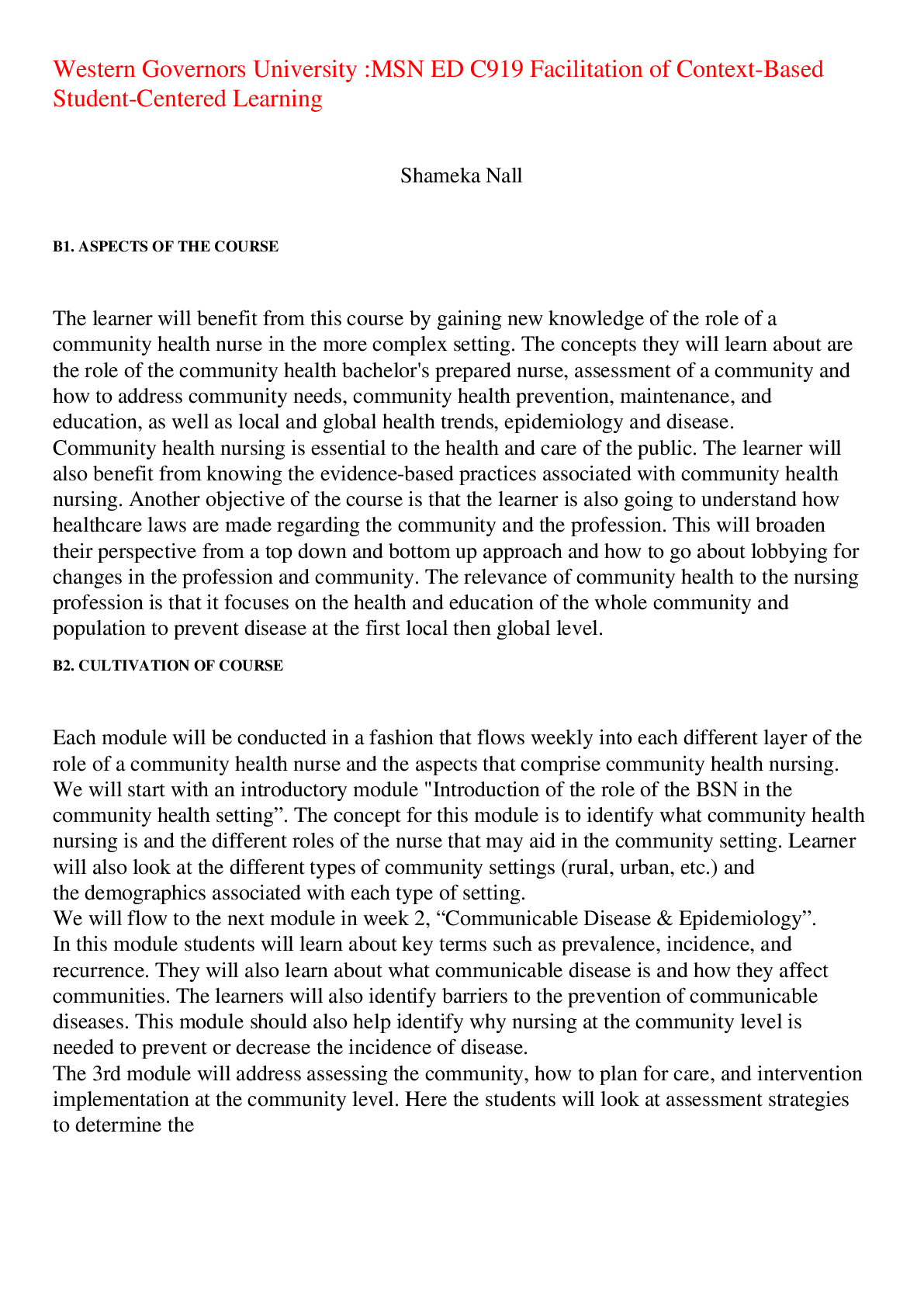
Buy this document to get the full access instantly
Instant Download Access after purchase
Buy NowInstant download
We Accept:

Reviews( 0 )
$14.00
Can't find what you want? Try our AI powered Search
Document information
Connected school, study & course
About the document
Uploaded On
Mar 12, 2023
Number of pages
11
Written in
Additional information
This document has been written for:
Uploaded
Mar 12, 2023
Downloads
0
Views
95


